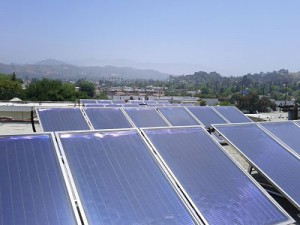By Aaron Block
Through renewable energy incentives and renewable portfolio standards (RPS), our state governments should be encouraging desirable results – less pollution, energy independence, and job creation – not betting on specific technologies. Solar is ideal for  accomplishing all of these goals, but why do we find ourselves so often limited to just to electricity generating technologies?
accomplishing all of these goals, but why do we find ourselves so often limited to just to electricity generating technologies?
Both PV and Solar water heating (SWH) are technologies that capture sunlight and convert it to energy for use in the home or business, both help us move away from fossil fuels, domestic and foreign, and both create sustainable job growth. I am not saying that we should forsake PV, but merely that we should give equal consideration to other solar technologies, ones that help us accomplish the same goals.
Energy and the Environment
The pollution reduction qualities of SWH and PV are virtually identical, and it hardly makes sense to treat the two technologies as different in this account. PV generates electricity, which reduces the load that must be borne by central power plants; SWH generates heat energy, which reduces the amount of fuel, which must be burned in the home. Water heating in the US comes, virtually entirely, from natural gas -the same fuel being used in power plants offset by PV. (Coal-based power is overwhelmingly base load, a portion of power consumption which most solar today can’t touch.) That’s right: while they affect different points in the energy chain, the pollution benefits of the two technologies are nearly identical.
There’s actually reason to believe that the pollution reduction from SWH exceeds that of PV. Central station generation – offset by PV – is easily monitored and regulated for pollution. There are no such mechanisms for water heaters, where pollutants are released straight into the home.
With an equal or better environmental record, why is our renewable energy legislation still treating SWH like PV’s tag-along younger brother?
Job Creation
Of course, in today’s economic climate, it doesn’t make sense to discuss legislation without addressing the question of jobs. There is no doubt that domestic renewable energy creates jobs. The solar industry alone employs over 100,000 people. As an engine of job growth, however, SWH has at least as much potential as PV, provided we give it the opportunity to flourish.
SWH creates sustainable, green collar jobs for in the local economy. One study found that a one-panel system on a single family home “…require[s] up to 32 hours of labor per installation,” – A small to medium sized apartment building easily requires 200+ hours of labor.
PV projects also generate local installation jobs but, given the relatively high cost of PV technology, less of each dollar spent remains in the local economy. Even manufacturing dollars are more likely to stay local with SWH. In 2009, 78% of the domestically installed SWH capacity was manufactured domestically, compared to 45% for PV.
Solar water heating is a mature technology already well understood by the American job market, and we should be putting it to work creating plumbing, framing and glazing jobs, not letting it sit by the sidelines.
The purpose of this article is not to belittle PV, or even to say that we should reduce the emphasis we have put on it. I am merely arguing that we should give equal consideration to SWH, a technology which accomplishes all of the same goals as PV. Those incentives we have so successfully used to encourage the development of PV should be extended to include solar water heating. Obviously there is no silver bullet to accomplishing our goals of job creation, energy security, and environmental sustainability, but it is unwise to use just one of the weapons in our arsenal, when many are viable.
Aaron Block works in Market Development for commercial solar water heating finance provider Skyline Innovations.
Free Hot Water welcomes guest blog posts from solar hot water developers and installers. Send submissions to solarfred@freehotwater.com.




















